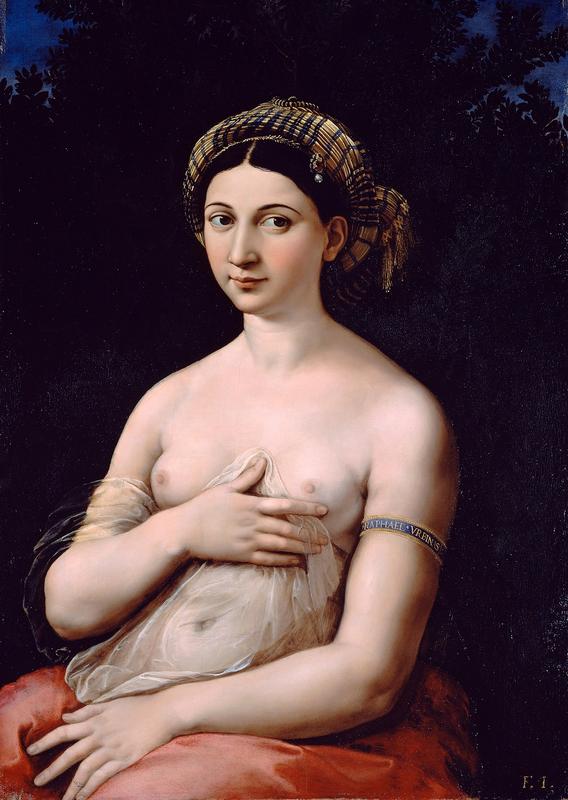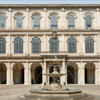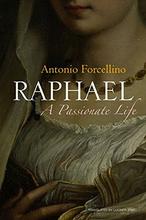More about La Fornarina
- All
- Info
- Shop

Contributor
The story of La Fornarina is an intriguing tale of love, lies, and politics...but only if you know where to look.
Renaissance painter Raphael painted the love of his life Margherita Luti. This drop-dead gorgeous woman was the daughter of a baker from Siena. Raphael got himself into some trouble when he slid into Margherita’s bedsheets, as he was already engaged to Maria Bibbiena. Maria was the niece of his patron, who also happened to be a very rich and powerful Roman cardinal. Margherita was from humble beginnings in Trastevere and was, until recently, thought to be Raphael's mistress. But recent scholarship on this painting reveals she may have been much more.
Margherita was his muse, the love of his life, and a recurring subject in Raphael’s art. In La Fornarina (a nickname meaning 'little bakeress'), Raphael painted a band of blue silk around her upper arm. Across the band, printed in gold, is Raphael’s full name. This is a highly unusual way to sign a painting, and as such seem to be an indication not only of the artwork’s creator, but also to whom the sitter belongs. It’s like she tattooed her lover’s name on her arm. Clearly, as written, Margherita hearts Raphael.
It clearly went both ways, as the painting is full of symbols indicating Raphael’s love for her. The background foliage of the painting includes myrtle and quince, which are symbols of love, loyalty, and fertility. The pearl dangling from her hair is a visual pun referring to her name, as 'margarita' is the Latin word for pearl. The pearl is attached to an ornate brooch pinned to an expensive silk turban, the kind that a woman would reserve for her wedding day. Such allegories may seem benign to the contemporary viewer, but would have been apparent to a Renaissance era audience, which is why there was never any intent to display La Fornarina publicly. So, what was Raphael hiding?
Sometimes it takes technology to reveal the intentions of artists from way back when. Thanks to the work of X-rays during a cleaning and restoration in 2000, it was revealed that Raphael liked it and put a ring on it. On the third finger of Margherita's left hand was painted a square-cut ruby ring, which was subsequently covered up by Raphael's students after his death, along with the symbolic bushes in the background. The painting was unfinished when he died, so one theory is that his students performed a literal cover-up in order to hide evidence of a secret marriage between Raphael and Margherita. See, at the time of Raphael's death, his school was doing an incredibly important commission for the Vatican, and if anyone saw the painting as he left it, with so many clues to their illicit matrimony, they could lose the job.
To drive the point home that Raphael definitely did not wed his lower class mistress, his students placed a plaque on his tomb in memory of his fiancee Bibbiena, who was buried next to him. Margherita was now persona non grata. Only four months after her beloved painter died, she registered as a widow in a convent for fallen women in Rome. Her legacy lives on, though. The intrigue related to the possibility of a secret romance has made the painting one of Raphael's most popular works, and sparked tons of debate among art historians. Some have even compared the slyly smirking woman in this mysterious portrait to Leonardo da Vinci's Mona Lisa.
Sources
- Baratta, Ilaria, “Un amore che durera per l’eternita: Raffaello e la Fornarina,” Finestre sull’ Arte, February 14, 2018. Accessed November 13, 2019. https://www.finestresullarte.info/827n_amore-raffaello-e-fornarina.php
- Burke, Jason, “X-ray vision reveals how Old Master hid his love for the baker’s daughter,” The Guardian, April 30, 2001. Accessed November 12 2019. https://www.theguardian.com/world/2001/apr/29/highereducation.arts
- Carrigan, Margaret, “The 10 best artworks by Raphael, Seraphic genius of the Renaissance – Ranked,” Artnet news, August 10, 2017. Accessed November 8, 2019. https://news.artnet.com/art-world/10-greatest-artworks-raphael-seraphic…-
- Cohen, Alina, “Understanding Renaissance Master Raphael through 5 key artsworks,” Artsy, April 16, 2019. Accessed November 8, 2019. https://www.artsy.net/article/artsy-editorial-understanding-renaissance…
- Gay, Peter, Modernism: the Lure of Heresy: from Baudelaire to Beckett and Beyond. New York: W.W. Norton and Company, 2008.
- Lathers, Marie, Bodies of Art: French Literary Realism and the Artist’s Model. London: University of Nebraska Press, 2001.
- McMahon, Barbara, “Art sleuth uncovers clue to secret Raphael marriage,” The Guardian, June 18, 2005. Accessed November 12, 2019. https://www.theguardian.com/world/2005/jun/18/italy.arts
- Smee, Sebastian, “A 19th-century painting that rivals the Mona Lisa,” Washington Post, September 25, 2018. Accessed November 8, 2019. https://www.washingtonpost.com/entertainment/museums/a-19th-century-pai…
- Sebastian Smee, “Hero worship, with nerve in ‘Raphael and the Fornarina,” Boston Globe, June 12, 2012. Accessed November 8, 2019. https://www.bostonglobe.com/arts/theater-art/2012/06/11/frame-frame-rap…
- Wanted in Rome, “Where to see Raphael’s art,” August 29, 2019. Accessed November 13, 2019. https://www.wantedinrome.com/news/where-to-see-raphaels-work-in-rome.ht…
Featured Content
Here is what Wikipedia says about La Fornarina
The Portrait of a Young Woman (also known as La fornarina) is a painting by the Italian High Renaissance master Raphael, made between 1518 and 1519. It is in the Galleria Nazionale d'Arte Antica in Palazzo Barberini, Rome.
It is probable that the picture was in the painter's studio at his death in 1520, and that it was modified and then sold by his assistant Giulio Romano.
Art-history tradition or legend identifies the woman as the fornarina ("baker" or "baker's daughter") Margherita Luti, Raphael's Roman lover who refused to marry him, though this identification has been questioned. An alternative view sees the work not as a portrait of a specific woman, but rather as Raphael's interpretation of a belle donne genre and a depiction of a courtesan. Still another interpretation identifies the figure as a witch.
Check out the full Wikipedia article about La Fornarina













